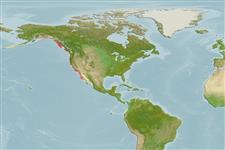Gastropoda |
Trochida |
Tegulidae
Environment: milieu / climate zone / djupintervall / distribution range
Ekologi
. Subtropical
Eastern Pacific: British Columbia, Canada to Mexico.
Length at first maturity / Size / Weight / Age
Könsmognad: Lm ? range ? - ? cm Max length : 3.0 cm SHD hane/ej könsbestämd; (Ref. 95344); common length : 2.5 cm TL hane/ej könsbestämd; (Ref. 312); rapporterad maxålder: 28 år (Ref. 2823)
Shell is thick and dark purple to black; foot is black on the sides (Ref. 312).
It has a shell length of 2.5 cm. Fisheries: Over-harvesting for food in the early 1900s, mainly by Southern European immigrants, caused a drastic drop in population numbers. Today they are still harvested by both Americans of Southern European and Asian ancestries; heavy regulation by the Department of Fish and Game has allowed populations to recover (Ref. 312). Habitat: Occurs in high to middle intertidal zones on rocky surfaces or in pools not covered in algae. Diet: eats many species of algae including micro and macroscopic. Life span: up to 25 years (Ref. 312).
Life cycle and mating behavior
Könsmognad | Reproduktion | Lek | Eggs | Fecundity | Larvae
Members of the order Archaeogastropoda are mostly gonochoric and broadcast spawners. Life cycle: Embryos develop into planktonic trocophore larvae and later into juvenile veligers before becoming fully grown adults.
Gallivan, G. and J. Danforth 1999 Phylum Mollusca. Marine Science Institute. Http://216.239.51.104/search?q=cache:EEiLeA0OeAMJ:www2.ucsc.edu/simp/guide.pdf+Nuttalina+californica&hl=tl&gl=ph&ct=clnk&cd=8 [accessed 20/01/06] (Ref. 312)
IUCN Red List Status
(Ref. 130435: Version 2025-1)
CITES status (Ref. 108899)
Not Evaluated
Not Evaluated
Threat to humans
Human uses
| FishSource |
Verktyg
Ytterligare information
Trophic EcologyFood items (preys)FödosammansättningFödointagPredatorer Population dynamicsTillväxtMax. ages / sizesLength-weight rel.Length-length rel.Length-frequenciesMass conversionAbundans PhysiologySyreförbrukning
Human RelatedStamps, coins, misc.
Internet-källor
Estimates based on models
Preferred temperature
(Ref.
115969): 9.5 - 17.9, mean 11.1 (based on 132 cells).
Fishing Vulnerability
Moderate vulnerability (45 of 100).
Price category
Unknown.
